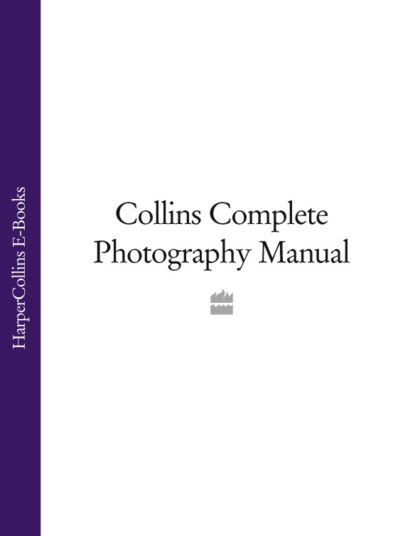По всем вопросам обращайтесь на: info@litportal.ru
(©) 2003-2024.
✖
Collins Complete Photography Manual
Автор
Год написания книги
2018
Настройки чтения
Размер шрифта
Высота строк
Поля
The next step is to check the scanning resolution and output size options. This can often be the cause of much confusion. The simplest solution is generally to leave the output image size the same as the original’s (or set the ‘scaling’ to 100 per cent) and then choose a resolution figure appropriate to the item that you are scanning. Afigure of 300dpi or 600dpi is usually plenty for scanning prints, and 2700dpi or 4000dpi will suffice when scanning slides or negatives.
Image formats
Finally, you will need to choose the format of your scanned image file. The JPEG format produces the smallest files and is usually the most efficient option. If you set the ‘quality’ to ‘high’ there will be a negligible loss in quality compared to other formats.
The Future of Photography
Experience has shown that trying to predict the future is fraught with problems. It is all too easy to get things laughably wrong. There are two types of change: evolution and revolution. Evolution is easiest to anticipate. You start from where you are now and simply project forward. But progress is rarely linear and logical. Which of us at the turn of the century would have anticipated that within five years virtually every mobile phone would incorporate a digital camera?
Pixel count
One thing we can be reasonably sure of in the future of photography is that camera pixel count will continue to rise – though how much benefit that will be to anyone other than the professional photographer is another matter entirely. The resolution currently available on even inexpensive models of digital camera is more than sufficient to produce quality images that will satisfy most amateurs – whether they want to view them on screen or make prints. Not many photographers often enlarge their pictures beyond A4, and that is easily achievable at the resolutions available today. However, that factor alone will not stop the pixel count rising – even though bigger files mean longer processing times and require more storage capacity.
Increased capacity
Higher resolutions will inevitably lead to an increase in the capacity of removable memory cards. Already you can buy cards that are capable of storing hundreds of quality images – enough for a whole year of picture taking for some photographers. One day, though, it might be possible to store an entire lifetime’s pictures on just one card. Doing so, however, without downloading or archiving them, would be a huge risk. Prudent photographers sensibly prefer to use several lower capacity cards just in case a card gets corrupted – which, happily, does not happen very often.
Screen size
Large screens on cameras will become the norm in the future, and the larger the better. Screens allow you to compose images more effectively, review them more accurately, and share your images with others more easily just after you have taken them. The limiting factor will be the size of the camera itself-which will surely remain as diminutive as possible.
Live preview on SLRs
Being able to see the subject ‘live’ on the LCD monitor has been the norm for many years – but for a long time SLR cameras only showed the image electronically after it had been taken. Pictures were still taken using the tried-and-tested reflex viewing system. In time all cameras will have live viewing, including SLRs, and it will seem perverse to have anything else.
Convergence
It seems likely that the various electronic items we use will gradually converge. Who wants to carry around lots of different gadgets? We are seeing this happen already, with phones featuring not only cameras but also music, email, games, the internet, diary and the capacity to play live and recorded video. Even so, it is likely to be some time before the SLR, used by most photo enthusiasts, goes the way of the dinosaur.
chapter 2 Lenses and Accessories (#ulink_c65a0a23-d02d-5c70-a226-be31277db3d9)
It is the enormous range of lenses and accessories on the market that makes photography so creative and so enjoyable. Compact digital cameras now generally have a zoom lens with a decent angle from wide-angle to telephoto – making it possible to tackle most popular subjects successfully. Step up to SLR ownership and there are no limits to what can be achieved photographically. Lenses and accessories are available to meet every possible need – from capturing distant subjects such as wildlife and sport to revealing the splendour of vast interiors or panoramic vistas. If you can imagine it, you can take it.
Understanding Lenses
Single lens reflex cameras enable you to change lenses to achieve a variety of effects. The camera’s standard lens will give an angle of view roughly similar to that we perceive with the naked eye, a wide-angle lens enables you to get more into the frame, while a telephoto magnifies distant objects.
There are other lens properties to take into account, apart from their focal length, including the maximum aperture. The larger the maximum aperture, the more light the lens can gather. This is useful in poor light or whenever you want shallow depth-of-field in your photographs, perhaps for throwing backgrounds out of focus, or for creating a similar effect.
Zoom lenses
In modern cameras, zoom lenses have largely taken over from lenses with fixed focal lengths (‘prime’ lenses). The versatility of zooms means that you do not have to carry around a number of different prime lenses, or keep changing lenses for different subjects.
However, zoom lenses do have a couple of intrinsic disadvantages. One is that their maximum apertures are lower than those of prime lenses. Whereas a 50mm prime lens might have a maximum aperture of f/1.8, a typical ‘standard zoom’ might have a maximum aperture off/4 at this focal length.
Lens mounts
Each digital SLR brand uses a different lens mount. A Nikon lens, for example, will not fit a Canon camera. However, you do not have to buy lenses made by your camera’s maker. Independent companies such as Sigma, for example, make lenses which can be supplied in different mounts according to the brand of camera you are using. These lenses are just as serviceable as those supplied by leading camera firms.
EQUIVALENT FOCAL LENGTH
Photographers using 35mm cameras are used to judging the angle of view of a lens by its focal length. However, with a couple of exceptions, digital SLRs have physically smaller sensors, so that the angle of view of the lens is reduced and it appears to have a longer focal length. You need to multiply the actual focal length by a factor of 1.5 or 1.6 to get its ‘effective’ focal length. For example, on a digital SLR a 50mm lens effectively becomes an 80mm lens.
Independent lenses versus marque lenses
Lenses made by independent companies are generally much cheaper than those offered by the camera maker. The optical performance is often very good and it may be difficult to see the difference in image quality between photographs taken using a good-quality independent lens and those taken on a more expensive ‘marque’ lens.
Having said that, when you buy a lens you are not just paying for image quality. Marque lenses may be better made than those from independent companies and are consequently more likely to withstand years of hard use. Their design and finish will be consistent with other lenses in the same range, and with the camera bodies which they are designed to accompany, and the lens range may include more sophisticated and specialized lenses that you cannot get elsewhere.
Standard Lenses
Digital cameras may be sold in ‘body-only’ form, but this option will normally only appeal to buyers who already have compatible lenses. Most buyers will choose a camera kit that includes both the body and a standard lens.
Although most new cameras come with zoom lenses fitted these days, until fairly recently film cameras were supplied with only a fixed focal length lens. Atypical standard lens has a focal length of 50mm or thereabouts, and is designed for general-purpose photography. Its angle of view closely matches that of the human eye, although some photographers feel that a 45mm lens is closer to the ideal. With a lens like this, the framing and perspective of shots looks natural, and this type has a large maximum aperture of f/1.8 or f/1.4. This makes it especially useful for shooting in low light or where you want shallow depth-of-field.
50mm standard lenses are light and compact, but some makers have produced shorter ‘pancake’ lenses for photographers who want their camera and lens to be slimmer still. These have a focal length of around 40mm and a smaller maximum aperture off/2.8, but their optical quality is usually excellent. They are more expensive, but for many photographers they are also more useful as standard lenses.
Standard zoom lenses
The zoom lenses that are a standard feature of most cameras sold today offer greater flexibility than the fixed focal length lenses of the past, covering a range of focal lengths from wide-angle through to telephoto.
On a film camera, the usual standard zoom has a focal range of 28-90mm. On a digital SLR it is usually 18-55mm, which gives a comparable angle of view. You can use a 28-90mm film lens on a digital SLR, but the focal range is not ideal, because it does not provide proper wide-angle coverage on the smaller sensor.
Zoom ranges are sometimes quoted as a factor – for example, ‘3x’, ‘4x’ or ‘5x’. This figure indicates the change in magnification across the zoom range. A 28-gomm zoom offers a 3.2x zoom range, for example, while a 28-135mm is a 4.8x zoom.
Zoom lenses with a longer focal range are more desirable, but they are also more expensive and much heavier. A lighter, inexpensive lens may be more useful on a camera that is going to be carried around all day.
USES FOR STANDARD LENSES
Standard prime lenses are good for full-length portraits, because you stand far enough away to prevent distortion but not so far away that you run out of space when working in small rooms.
The large maximum aperture of a standard prime lens will make it ideal for taking pictures at parties and celebrations where you don’t want to use flash, which could disturb the subjects.
A standard 28-90mm zoom lens (or its digital equivalent) is perfect for everyday photography, because it is compact and light and you will seldom need focal lengths outside this range.
Standard zooms are perfect for travel photography as well, in situations where there is often little time to change lenses or viewpoints. For this kind of work, a slightly longer zoom range (28-135mm, for example) can be an advantage.
Wide-Angle Lenses
A wide-angle lens enables you to get more into the frame of your image. At the same time it makes objects seem smaller and further away. A wide-angle lens has an obvious, practical value if you are trying to photograph a sweeping landscape or if you are taking pictures in confined spaces.
The term ‘wide-angle’ covers a range of focal lengths. On a 35mm film camera, a 35mm lens would be considered a modest wide-angle and a 28mm lens a ‘proper’ wide-angle. 20mm lenses are ‘super-wides’, and considerably more expensive.
The standard zooms supplied with modern cameras usually have a minimum focal length of 28mm, which is probably as wide as you will usually need to go.
Just as there are super-wide fixed focal length lenses, so there are wide-angle zooms, which cover similar focal lengths, such as 16-40mm on a 35mm camera, or a 10-20mm lens on a digital SLR. These lenses are bulkier and more expensive than standard zooms.
WIDE-ANGLE PERSPECTIVE











